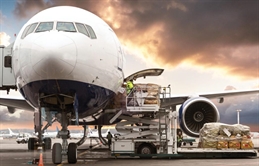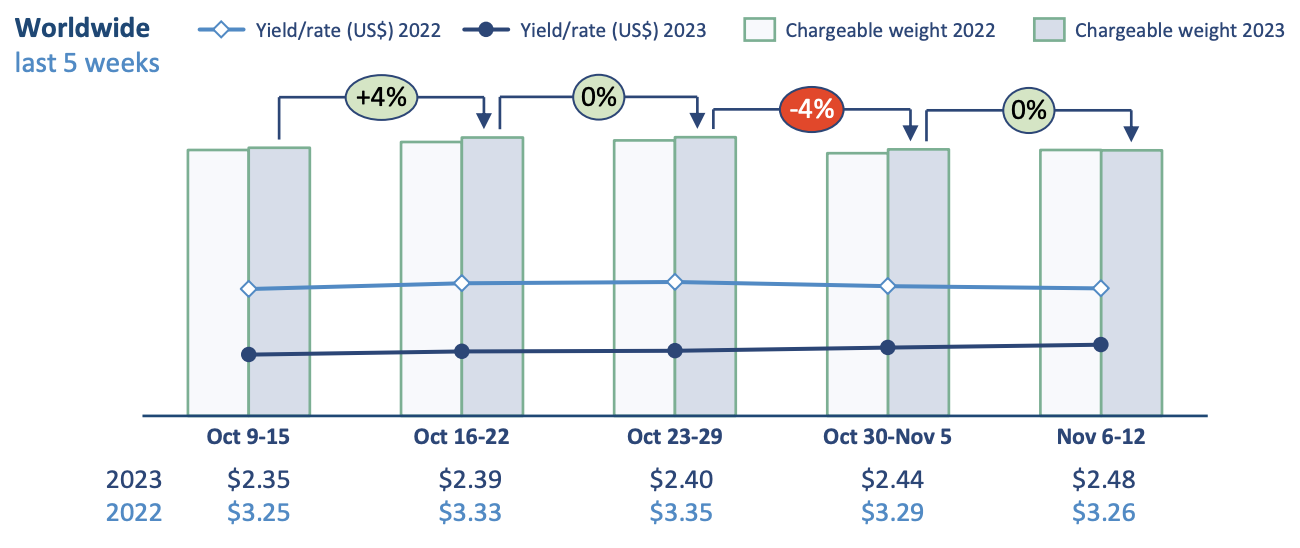
Worldwide average air cargo prices have continued their gradual post-summer rise into the first full week of November, while global tonnages have stabilized slightly above their level this time last year, according to the latest figures from WorldACD Market Data.
The air cargo market data provider noted, though, that halfway through the market's traditionally buoyant fourth-quarter (Q4) period, there are "no signs of any strong peak in demand," with demand patterns so far broadly mirroring last year's disappointing Q4.
WorldACD said after overall worldwide tonnages dropped by around -4% from the end of October into the first few days of November, preliminary figures for week 45 (November 6 to 12) show stable tonnages compared with the previous week and a +2% increase in global average rates.

[Source: WorldACD]
Throughout October and the beginning of November, tonnages have followed a broadly similar pattern as they did this time last year, but with some small improvements compared with 2022's trends — for example, there was a slight week-over-week decrease in week 45 last year (-1%) following a -6% decline in week 44.
But comparing weeks 44 and 45 this year with the preceding two weeks (2Wo2W), WorldACD said overall tonnages dropped -5% — due chiefly to that fall in chargeable weight in week 44 — while rates increased by +3% and capacity was slightly lower (-2%) than the combined total in weeks 42 and 43.
Contributing to that 2Wo2W overall global -5% volume decline, tonnages have been on a negative 2Wo2W trend for almost all region-to-region flows, most notably outbound from North America to Asia Pacific (-13%), intra-Asia Pacific (-11%) and outbound from Central & South America to Europe (-11%).
Furthermore, weakening tonnage flows were recorded outbound from Europe to, respectively, Central & South America (-9%), Asia Pacific (-8%), Middle East & South Asia (-7%), North America (-5%) and Africa (-3%), and outbound from North America to, respectively, Central & South America (-5%) and Europe (-5%).
WorldACD noted that the only (slightly) positive tonnage development was observed outbound from Asia Pacific to Europe (+2%).
 [Source: WorldACD]
[Source: WorldACD]
On the pricing side, the overall 2Wo2W increase of +3% was mainly driven by the origin region Asia Pacific (+6%), including notable increases to Europe (+5%), North America (+4%) and Middle East & South Asia (+4%).
It said that higher Asia Pacific to North America prices may have been partly inflated by operational disruptions caused by severe snow at Alaska's Anchorage Airport.
Global volumes, capacity up while rates decline
"After many months of reporting year-on-year tonnage declines, on a global and regional basis, overall global volumes are now slightly (+1%) higher than their levels this time last year — even if those levels were relatively subdued — and tonnages from a number of origin regions are now significantly above their equivalent levels," WorldACD said in its report.
It added that chargeable weight in weeks 44 and 45 went up +10% ex-Asia Pacific, +8% ex-Middle East & South Asia, +7% ex-Africa and +5% ex-Central & South America. But, as in previous recent reports, there were significant decreases in tonnages ex-North America (-13%) and ex-Europe (-8%).
Meanwhile, overall available capacity has increased by +13% compared with last year, with capacity ex-Asia Pacific up by a noteworthy +42%.
It added that worldwide average rates are currently -25% below their levels this time last year, at an average of US$2.48 per kilo in week 45, although they remain significantly above pre-Covid levels (+36% compared to November 2019).



